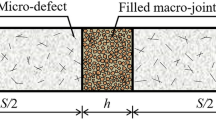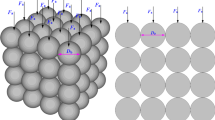Abstract
In the context of deep rock engineering, the in-situ stress state is of major importance as it plays an important role in rock dynamic response behavior. Thus, stress initialization becomes crucial and is the first step for the dynamic response simulation of rock mass in a high in-situ stress field. In this paper, stress initialization methods, including their principles and operating procedures for reproducing steady in-situ stress state in LS-DYNA, are first introduced. Then the most popular four methods, i.e., explicit dynamic relaxation (DR) method, implicit-explicit sequence method, Dynain file method and quasi-static method, are exemplified through a case analysis by using the RHT and plastic hardening rock material models to simulate rock blasting under in-situ stress condition. Based on the simulations, it is concluded that the stress initialization results obtained by implicit-explicit sequence method and dynain file method are closely related to the rock material model, and the explicit DR method has an obvious advantage in solution time when compared to other methods. Besides that, it is recommended to adopt two separate analyses for the whole numerical simulation of rock mass under the combined action of in-situ stress and dynamic disturbance.
摘要
在深部岩体工程中, 岩体在动态扰动作用下的响应行为与其自身的原位地应力状态密切相关, 因此, 岩体应力初始化作为高地应力岩体动态响应数值模拟的第一步, 其作用至关重要. 首先, 介绍了基于 LS-DYNA 的应力初始化方法, 包括模拟中再现稳定原位应力状态的基本原理及其相应的操作步骤. 其后, 通过实例分析, 以 RHT 和塑性硬化岩石材料模型为基础, 采用四种常用的应力初始化方法 (即显式动态松弛法、隐-显式序列法、 Dynain 文件法和准静态方法) 模拟高地应力条件下的岩体爆破响应. 通过模拟对比得出, 以隐-显式序列法和 Dynain 文件法获得的应力初始化结果与所选用的岩石材料模型密切相关, 而在求解时间方面, 显式动态松弛法较其他方法具有明显优势. 此外, 在原位应力和动态扰动共同作用下的岩体响应模拟过程中, 为便于实际操作, 建议采取两步骤相继独立分析 (地应力分析和动态分析) 的方式开展数值模拟工作.
Similar content being viewed by others
References
LI **-bing, ZHOU Jian, WANG Shao-feng, LIU Bing. Review and practice of deep mining for solid mineral resources [J]. Chinese Journal of Nonferrous Metals, 2017, 27(6): 1236–1262. DOI: https://doi.org/10.19476/j.ysxb.1004.0609.2017.06.021. (in Chinese)
WANG Shao-feng, SUN Li-cheng, HUANG Lin-qi, LI **-bing, SHI Ying, YAO **-rui, DU Shao-lun. Non-explosive mining and waste utilization for achieving green mining in underground hard rock mine in China [J]. Transactions of Nonferrous Metals Society of China, 2019, 29(9): 1526–1533. DOI: https://doi.org/10.1016/s1003-6326(19)65099-5.
XIE L X, LU W B, ZHANG Q B, JIANG Q H, CHEN M, ZHAO J. Analysis of damage mechanisms and optimization of cut blasting design under high in-situ stresses [J]. Tunnelling and Underground Space Technology, 2017, 66: 19–33. DOI: https://doi.org/10.1016/j.tust.2017.03.009.
LIU Ke-wei, LI **ao-han, LI **-bing, YAO Zhi-hua, SHU Zong-xian, YUAN Ming-hua. Characteristics and mechanisms of strain waves generated in rock by cylindrical explosive charges [J]. Journal of Central South University, 2016, 23: 2951–2957. DOI: https://doi.org/10.1007/s11771-016-3359-7.
LIU Ke-wei, HAO Hong, LI **-bing. Numerical analysis of the stability of abandoned cavities in bench blasting [J]. International Journal of Rock Mechanics and Mining Sciences, 2017, 92: 30–39. DOI: https://doi.org/10.1016/j.ijrmms.2016.12.008.
LIU Ke-wei, YANG Jia-cai, LI **-bing, HAO Hong, LI Qi-yue, LIU Zhi-xiang, WANG Chun-yi. Study on the long-hole raising technique using one blast based on vertical crater retreat multiple deck shots [J]. International Journal of Rock Mechanics and Mining Sciences, 2018, 109: 52–67. DOI: https://doi.org/10.1016/j.ijrmms.2018.06.020.
LIU Ke-wei, LI Xu-dong, HAO Hong, LI **-bing, SHA Yan-yan, WANG Wei-hua, LIU **-ling. Study on the raising technique using one blast based on the combination of long-hole presplitting and vertical crater retreat multiple-deck shots [J]. International Journal of Rock Mechanics and Mining Sciences, 2019, 113: 41–58. DOI: https://doi.org/10.1016/j.ijrmms.2018.11.012.
PENG Shu-quan, WANG Fan, LI **-bing, FAN Lin, GONG Feng-qiang. A microbial method for improving salt swelling behavior of sulfate saline soil by an experimental study [J]. Alexandria Engineering Journal, 2019, 58(4): 1353–1366. DOI: https://doi.org/10.1016/j.aej.2019.11.006
CARTER J P, BOOKER J R. Sudden excavation of a long circular tunnel in elastic ground [J]. International Journal of Rock Mechanics and Mining ences & Geomechanics Abstracts, 1990, 27(2): 129–132. DOI: https://doi.org/10.1016/0148-9062(89)91329-6.
LI **-bing, CAO Wen-zhuo, ZHOU Zi-long, ZHOU yang. Influence of stress path on excavation unloading response [J]. Tunnelling and Underground Space Technology, 2014, 42: 237–246. DOI: https://doi.org/10.1016/j.tust.2014.03.002.
ZHU W C, WEI J, ZHAO J, NIU L L. 2D numerical simulation on excavation damaged zone induced by dynamic stress redistribution [J]. Tunnelling and Underground Space Technology Incorporating Trenchless Technology Research, 2014, 43: 315–326. DOI: https://doi.org/10.1016/j.tust.2014.05.023.
YANG J H, JIANG Q H, ZHANG Q B, ZHAO J. Dynamic stress adjustment and rock damage during blasting excavation in a deep-buried circular tunnel [J]. Tunnelling and Underground Space Technology, 2018, 71: 591–604. DOI: https://doi.org/10.1016/j.tust.2017.10.010.
GONG Feng-qiang, LUO Yong, LI **-bing, SI Xue-feng, TAO Ming. Experimental simulation investigation on rockburst induced by spalling failure in deep circular tunnels [J]. Tunnelling and Underground Space Technology, 2018, 81: 413–427. DOI: https://doi.org/10.1016/j.tust.2018.07.035.
GONG Feng-qiang, SI Xue-feng, LI **-bing, WANG Shan-yong. Experimental investigation of strain rockburst in circular caverns under deep three-dimensional high-stress conditions [J]. Rock Mechanics and Rock Engineering, 2018, 52(4): 1459–1474. DOI: https://doi.org/10.1007/s00603-018-1660-5.
SI Xue-feng, GONG Feng-qiang. Strength-weakening effect and shear-tension failure mode transformation mechanism of rockburst for fine-grained granite under triaxial unloading compression [J]. International Journal of Rock Mechanics and Mining Sciences, 2020, 131: 104347. DOI: https://doi.org/10.1016/j.ijrmms.2020.104347.
DU Kun, TAO Ming, LI **-bing, ZHOU Jian. Experimental study of slabbing and rockburst induced by true-triaxial unloading and local dynamic disturbance [J]. Rock Mechanics and Rock Engineering, 2016, 49(9): 3437–3453. DOI: https://doi.org/10.1007/s00603-016-0990-4.
FAN Y, LU W B, YAN P, CHEN M, ZHANG Y Z. Transient characters of energy changes induced by blasting excavation of deep-buried tunnels [J]. Tunnelling and Underground Space Technology, 2015, 49: 9–17. DOI: https://doi.org/10.1016/j.tust.2015.04.003.
LU Wen-bo, YANG Jian-hua, PENG Yan, CHEN Ming, ZHOU Chuang-bing, LUO Yi, JIN Li. Dynamic response of rock mass induced by the transient release of in-situ stress [J]. International Journal of Rock Mechanics and Mining Sciences, 2012, 53: 129–141. DOI: https://doi.org/10.1016/j.ijrmms.2012.05.001.
JU Yang, REN Zhang-yu, ZHENG Jiang-tao, GAO Feng, MING Ling-tao, CHIANG Fu-pen, XIE He-**. Quantitative visualization methods for continuous evolution of three-dimensional discontinuous structures and stress field in subsurface rock mass induced by excavation and construction—An overview [J]. Engineering Geology, 2020, 265: 1–14. DOI: https://doi.org/10.1016/j.enggeo.2019.105443.
SAMAR S A, YANN G, VINCENT R, MARWAN A. Initialization of highly heterogeneous virgin stress fields within the numerical modeling of large-scale mines [J]. International Journal of Rock Mechanics and Mining Sciences, 2017, 99: 50–62. DOI: https://doi.org/10.1016/j.ijrmms.2016.04.006.
DAI Ru-lin, LI Zhong-fang, WANG Jiao. Research on initial geo-stress balance method based on ABAQUS [J]. Journal of Chongqing Technology and Business University(Natural Science Edition), 2012, 29(9): 76–81. DOI: https://doi.org/10.3969/j.issn.1672-058X.2012.09.016. (in Chinese)
LI Yong, GUO Yun-hua, ZHU Wei-shen, LI Shu-cai, ZHOU Hao. A modied initial in-situ stress inversion method based on FLAC3D with an engineering application [J]. Open Geosciences, 2015, 7(1): 824–835.
LIU Jun-guang, CHEN Qin-fa, YIN Ting-chang. Velocity-stress boundary method to generate initial stress field of deep engineering in mine based on FLAC3D [J]. Metal Mine, 2018, 3: 26–31. DOI: https://doi.org/10.19614/j.cnki.jsks.201803005. (in Chinese)
YUAN Wei, SU Xue-bin, WANG Wei, WEN Lei, CHANG Jiang-fang. Numerical study of the contributions of shock wave and detonation gas to crack generation in deep rock without free surfaces [J]. Journal of Petroleum Science & Engineering, 2019, 177: 699–710. DOI: https://doi.org/10.1016/j.petrol.2019.02.004.
TIAN Li, LI Yong-xin. Analysis of damage effects of a prestressed reinforced concrete hollow beam subjected to the synergistic effects of blast and fragments [J]. Journal of Central South University (Science and Technology), 2019, 50(5): 1154–1164. DOI: https://doi.org/10.11817/j.issn.1672-7207.2019.05.019. (in Chinese)
JIANG Hua, CHORZEPA M G. An effective numerical simulation methodology to predict the impact response of pre-stressed concrete members [J]. Engineering Failure Analysis, 2015, 55: 63–78. DOI: https://doi.org/10.1016/j.engfailanal.2015.05.006.
CHEN Yi-yi, ZHANG Da-zhao, XUE Wei-chen, LU Wen-sheng. Seismic performance of prestressed concrete stand structure supporting retractable steel roof [J]. Frontiers of Architecture & Civil Engineering in China, 2009, 3(2): 117–124. DOI: https://doi.org/10.1007/s11709-009-0024-3.
DONG Jian-hua, ZHU Yan-peng, YONG Zhou, MA Wei. Dynamic calculation model and seismic response for frame supporting structure with prestressed anchors [J]. Science China Technological Sciences, 2010, 53(7): 1957–1966. DOI: https://doi.org/10.1007/s11431-010-3241-z.
WU Jian-hua, HAO Ding-di, LI Wen-sheng, REN **ao-dan. Numerical modeling and simulation of a prestressed concrete containment vessel [J]. Annals of Nuclear Energy, 2018, 21: 269–283. DOI: https://doi.org/10.1016/j.anucene.2018.06.039.
YI Chang-**, JOHANSSON D, GREBERG J. Effects of in-situ stresses on the fracturing of rock by blasting [J]. Computers and Geotechnics, 2018, 104: 321–330. DOI: https://doi.org/10.1016/j.compgeo.2017.12.004.
LI **-bing, GONG Feng-qiang, TAO Ming, DONG Long-jun, DU Kun, MA Chun-de, ZHOU Zi-long, YIN Tu-bing. Failure mechanism and coupled static-dynamic loading theory in deep hard rock mining: A review [J]. Journal of Rock Mechanics and Geotechnical Engineering, 2017, 9(4): 767–782. DOI: https://doi.org/10.1016/j.jrmge.2017.04.004.
LS-DYNA. Keyword user’s manual Volume I, Ver. 971 [M]. Livermore: Livermore Software Technology Corporation (LSCT), 2012.
BARNES M. Form finding and analysis of tension structures by dynamic relaxation [J]. International Journal of Space Structures, 1999, 14(2): 89–104. DOI: https://doi.org/10.1260/0266351991494722.
BING Dao. Stress initialization in LS-DYNA [EB/OL]. 2016-07-23. http://www.jishulink.com/content/post/284766. (in Chinese)
STREETER M, RHODE-BARBARIGOS L, ADRIAENSSENS S. Form finding and analysis of inflatable dams using dynamic relaxation [J]. Applied Mathematics & Computation, 2015, 267: 742–749. DOI: https://doi.org/10.1016/j.amc.2014.12.054.
ZHAO Hua-tao, TAO Ming, LI **-bing, CAO Wen-zhuo, WU Cheng-qing. Estimation of spalling strength of sandstone under different pre-confining pressure by experiment and numerical simulation [J]. International Journal of Impact Engineering, 2019, 133: 1–11. DOI: https://doi.org/10.1016/j.ijimpeng.2019.103359. https://www.dynasupport.com/howtos/implicit/implicit-dynamic-relaxation.
LS-DYNA Support. Implicit: Dynamic relaxation [EB/OL]. https://www.dynasupport.com/howtos/implicit/implicit-dynamic-relaxation.
HALLQUIST J O. LS-DYNA Theory Manual [M]. California: Livermore Software Technology Corporation.
JANG Rui-bin. The method of auto panel springback compensation based on dynain [J]. Mechanical & Electrical Engineering Technology, 2009, 38(6): 95–97. DOI: https://doi.org/10.3969/j.issn.1009-9492.2009.06.031. (in Chinese)
ANSYS documentation. Version 12.1, ANSYS LS-DYNA user’s guide [M]. Bei**g, China: ANSYS Inc., 2009.
WENG Lei, LI **-bing, TAO Ming. Influence of geostress orientation on fracture response of deep underground cavity subjected to dynamic loading [J]. Shock and Vibration, 20151: 575879. DOI: https://doi.org/10.1155/2015/575879.
CUI Jian, HAO Hong, SHI Yan-chao. Study of concrete damage mechanism under hydrostatic pressure by numerical simulations [J]. Construction & Building Materials, 2018, 160: 440–449. DOI: https://doi.org/10.1016/j.conbuildmat.2017.11.083.
LI **, WANG Bin, ZHOU Gui-long. Research on distribution rule of geostress in deep stratum in chinese mainland [J]. Chinese Journal of Rock Mechanics and Engineering, 2012, 31(z1): 2875–2880. DOI: https://doi.org/10.3969/j.issn.1000-6915.2012.z1.036. (in Chinese)
BLAIR D P. A comparison of Heelan and exact solutions for seismic radiation from a short cylindrical charge [J]. Geophysics, 2007, 72(2): 33–41. DOI: https://doi.org/10.1190/1.2424543.
YI Chang-**, JOHANSSON D, ULF N, BEYGLOU A. Stress wave interaction between two adjacent blast holes [J]. Rock Mechanics & Rock Engineering, 2016, 49(5): 1803–1812. DOI: https://doi.org/10.1007/s00603-015-0876-x.
YILMAZ O, UNLU T. Three dimensional numerical rock damage analysis under blasting load [J]. Tunnelling and Underground Space, 2013, 38: 266–278. DOI: https://doi.org/10.1016/j.tust.2013.07.007.
RIEDEL W, KAWAI N, KONDO K I. Numerical assessment for impact strength measurements in concrete materials [J]. International Journal of Impact Engineering, 2009, 36(2): 283–293. DOI: https://doi.org/10.1016/j.ijimpeng.2007.12.012.
BORRVALL T. The RHT concrete model in LS-DYNA [C]// 8th European LS-DYNA Conference. 2011.
DEHGHAN BANADAKI M M, MOHANTY B. Numerical simulation of stress wave induced fractures in rock [J]. International Journal of Impact Engineering, 2012, 40–41: 16–25. DOI: https://doi.org/10.1016/j.ijimpeng.2011.08.010.
ZHAO Jian-jian, ZHANG Yong, RANJITH P G. Numerical simulation of blasting-induced fracture expansion in coal masses [J]. International Journal of Rock Mechanics and Mining Sciences, 2017, 100: 28–39. DOI: https://doi.org/10.1016/j.ijrmms.2017.10.015.
HU Tao, LI **ang-long, GUAN Si, HE Li-hua. Numerical simulation of blasting effect with divided charge structures [J]. Engineering, 2014, 12(6): 39–45. DOI: https://doi.org/10.3969/j.issn.1009-1742.2014.11.005.
WANG Fang-tian, TU Shi-hao, YUAN Yong, FENG Yu-feng, CHEN Fang, TU Hong-sheng. Deep-hole pre-split blasting mechanism and its application for controlled roof caving in shallow depth seams [J]. International Journal of Rock Mechanics and Mining Sciences, 2013, 64: 112–121. DOI: https://doi.org/10.1016/j.ijrmms.2013.08.026.
Author information
Authors and Affiliations
Contributions
The overarching research goals were developed by LIU Ke-wei, YANG Jia-cai and LIU Zhi-xiang. LI Xu-dong and YANG Jia-cai analyzed the calculated results. The initial draft of the manuscript was written by YANG Jia-cai. All authors replied to reviewers’ comments and revised the final version.
Corresponding author
Additional information
Conflict of interest
YANG Jia-cai, LIU Ke-wei, LI Xu-dong and LIU Zhi-xiang declare that they have no conflict of interest.
Foundation item: Project(41630642) supported by the Key Project of National Natural Science Foundation of China; Project(51974360) supported by the National Natural Science Foundation of China; Project(2018JJ3656) supported by the Natural Science Foundation of Hunan Province, China
Rights and permissions
About this article
Cite this article
Yang, Jc., Liu, Kw., Li, Xd. et al. Stress initialization methods for dynamic numerical simulation of rock mass with high in-situ stress. J. Cent. South Univ. Technol. 27, 3149–3162 (2020). https://doi.org/10.1007/s11771-020-4535-3
Received:
Accepted:
Published:
Issue Date:
DOI: https://doi.org/10.1007/s11771-020-4535-3




